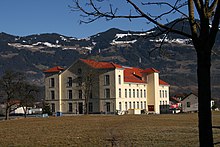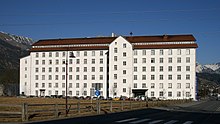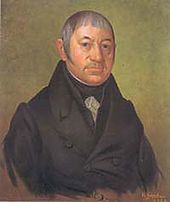Christian Getzner
Christian Getzner (born October 12, 1782 in Satteins ; † August 8, 1848 in Feldkirch ) was an Austrian entrepreneur and pioneer in textile production and co-founder of Getzner Textil AG in Bludenz .
family
Christian Getzner was one of seven children of a farming couple in Satteins. In this small Walgau community he attended elementary school.
His family is believed to have spun yarn for the wealthy trader Johann Josef Ganahl in Feldkirch. He supplied the raw cotton for it and then bought the yarn from them.
Life and work
Around 1800 he entered the trading business (colonial goods store) of Johann Josef Ganahl in Feldkirch as a commercial assistant .
- Bludenz
In 1806 he married the landlord's daughter Maria Barbara Katharina Barbisch from Bludenz . In her parents' house he founded a colonial and specialty goods store, in which, like Ganahl in Feldkirch, he also traded in cotton and cotton spun.
In 1815 he took on his wife's cousin, Andreas Gassner from Nenzing (* 1776; † 1823), as a partner and accountant. Two years later he took over the management of the business.
In the same year Franz Xaver Mutter (* 1776, † 1836) from Tobadill in the Landeck district set up a cutlery shop in Bludenz. On August 1, 1818, the three - Getzner, Mutter and Gassner - finally formed the company Getzner, Mutter & Cie. together.
In Bludenz he also ran the Brunnental Ganahl & Comp spinning mill from 1820 to 1832 with Johann Josef Ganahl and C. Daller-Fels, another partner from St. Gallen . After Rhomberg & Lenz in Dornbirn, this was the second larger company of its kind in Vorarlberg. The factory burned down in 1832 and was never rebuilt.


- Feldkirch and Frastanz
Getzner now shifted his interests to Feldkirch and he acquired the Palais Liechtenstein , where in 1819 he set up a machine spinning mill with four machines and started the first red dye works in Vorarlberg. He also ran a brewery.
However, problems soon arose: Getzner had not taken care of building permits and was producing without considering the risk of fire. The dye works also polluted the water that was used by others.
Getzner was therefore forced to relocate the dye works to Frastanz in Felsenau. He also had a rapid chemical bleaching facility set up there, again without prior approval. The operation was then banned for years.
- Nenzing and Bürs
In 1831 Getzner participated in the construction of a spinning mill in Nenzing and in 1836 a large spinning and weaving mill followed in Bürs .
At this point in time, they relocated around 3,000 homeworkers. The sales branches in Vienna, Linz and Verona also go back to the early days.
Christian Getzner died childless. He made his nephews Josef Getzner and Andreas Tschavoll a universal heir . He had trained both of them for their future tasks while they were still alive.
backgrounds
Important reasons for Getzner's rise from farmer's son to factory owner lay in his willingness to innovate: He experimented with machine spinning and red dyeing very early on; he often fought with the authorities and was anxious to eliminate potential competitors.
In his career there are remarkable parallels to his teacher Johann Josef Ganahl , another first generation entrepreneur:
- Like Ganahl in Feldkirch in 1797, Getzner also opened his first shop in his father-in-law's house, which he soon acquired.
- Shortly afterwards, both had to deal with family setbacks: Ganahl's wife died and Getzner's only two children did not survive the first year.
- As a result, Getzner and Ganahl concentrated on their economic advancement and thus contributed significantly to the development of large companies.
literature
- Getzner Christian. In: Austrian Biographical Lexicon 1815–1950 (ÖBL). Volume 1, Publishing House of the Austrian Academy of Sciences, Vienna 1957, p. 432 f. (Direct links on p. 432 , p. 433 ).
- Hans Nägele : Getzner, Christian. In: New German Biography (NDB). Volume 6, Duncker & Humblot, Berlin 1964, ISBN 3-428-00187-7 , p. 352 f. ( Digitized version ).
| personal data | |
|---|---|
| SURNAME | Getzner, Christian |
| BRIEF DESCRIPTION | Austrian textile industrialist |
| DATE OF BIRTH | October 12, 1782 |
| PLACE OF BIRTH | Satteins |
| DATE OF DEATH | August 8, 1848 |
| Place of death | Feldkirch |
